Improved Change Detection with Trajectory-Based Approach: Application to Quantify Cropland Expansion in South Dakota
Abstract
1. Introduction
2. Methods
2.1. Generation of Land Cover/Land Use Dataset
2.2. Characterizing Cropland Expansion Using The Trajectory-Based Change Detection
3. Results
3.1. Accuracy Assessment of Cropland Maps of South Dakota
3.2. Cropland Expansion in South Dakota
4. Discussion
4.1. Uncertainties in Land Cover/Land Use Dataset
4.2. Characterizing Land Changes Using the Trajectory-Based Approach
5. Conclusions
Supplementary Materials
Author Contributions
Funding
Acknowledgments
Conflicts of Interest
References
- Decision Innovation Solutions. 2014 South Dakota Agricultural Economic Contribution Study. Decision Innovation Solutions: Urbandale, IA 50322. Available online: https://sdda.sd.gov/office-of-the-secretary/publications/ (accessed on 15 December 2018).
- Wright, C.K.; Wimberly, M.C. Recent land use change in the Western Corn Belt threatens grasslands and wetlands. Proc. Natl. Acad. Sci. USA 2013, 110, 4134–4139. [Google Scholar] [CrossRef] [PubMed]
- Reitsma, K.D.; Clay, D.E.; Carlson, C.G.; Dunn, B.H.; Smart, A.J.; Wright, D.L.; Clay, S.A. Estimated South Dakota land use change from 2006 to 2012. iGrow Agronomy. 2014. Available online: https://igrow.org/up/resources/03-2001-2014.pdf (accessed on 15 December 2018).
- USDA-NASS (U.S. Department of Agriculture-National Agricultural Statistics Service). 2017 State Agriculture Overview: South Dakota. Available online: https://www.nass.usda.gov/Quick_Stats/Ag_Overview/stateOverview.php?state=SOUTH%20DAKOTA (accessed on 15 December 2018).
- Vaché, K.B.; Eilers, J.M.; Santelmann, M.V. Water quality modeling of alternative agricultural scenarios in the US Corn Belt. J. Am. Water Resour. Assoc. 2002, 38, 773–787. [Google Scholar] [CrossRef]
- Montgomery, D.R. Soil erosion and agricultural sustainability. Proc. Natl. Acad. Sci. USA 2007, 104, 13268–13272. [Google Scholar] [CrossRef] [PubMed]
- Stephens, S.E.; Walker, J.A.; Blunck, D.R.; Jayaraman, A.; Naugle, D.E.; Ringelman, J.K.; Smith, A.J. Predicting risk of habitat conversion in native temperate grasslands. Conserv. Biol. 2008, 22, 1320–1330. [Google Scholar] [CrossRef] [PubMed]
- Meehan, T.D.; Hurlbert, A.H.; Gratton, C. Bird communities in future bioenergy landscapes of the Upper Midwest. Proc. Natl. Acad. Sci. USA 2010, 107, 18533–18538. [Google Scholar] [CrossRef] [PubMed]
- Mutter, M.; Pavlacky, D.C.; Lanen, N.J.; Grenyer, R. Evaluating the impact of gas extraction infrastructure on the occupancy of sagebrush-obligate songbirds. Ecol. Appl. 2015, 25, 1175–1186. [Google Scholar] [CrossRef] [PubMed]
- Wimberly, M.C.; Narem, D.M.; Bauman, P.J.; Carlson, B.T.; Ahlering, M.A. Grassland connectivity in fragmented agricultural landscapes of the north-central United States. Biol. Conserv. 2018, 217, 121–130. [Google Scholar] [CrossRef]
- Faber, S.; Rundquist, S.; Male, T. Plowed Under: How Crop Subsidies Contribute to Massive Habitat Losses; Environmental Working Group: Washington, DC, USA, 2012. [Google Scholar]
- Decision Innovation Solutions. 2013 Multi-State Land Use Study: Estimated Land Use Changes 2007–2012. Urbandale, IA 50322: Decision Innovation Solutions. Available online: http://www.decision-innovation.com/spatial-time-series-analysis (accessed on 15 December 2018).
- Lark, T.J.; Salmon, J.M.; Gibbs, H.K. Cropland expansion outpaces agricultural and biofuel policies in the United States. Environ. Res. Lett. 2015, 10, 044003. [Google Scholar] [CrossRef]
- Arora, G.; Wolter, P.T. Tracking land cover change along the western edge of the US Corn Belt from 1984 through 2016 using satellite sensor data: Observed trends and contributing factors. J. Land Use Sci. 2018, 13, 59–80. [Google Scholar] [CrossRef]
- Nguyen, L.H.; Joshi, D.R.; Clay, D.E.; Henebry, G.M. Characterizing land cover/land use from multiple years of Landsat and MODIS time series: A novel approach using land surface phenology modeling and random forest classifiers. Remote Sens. Environ. 2018, 219. [Google Scholar] [CrossRef]
- De Beurs, K.M.; Henebry, G.M. Land surface phenology, climatic variation, and institutional change: Analyzing agricultural land cover change in Kazakhstan. Remote Sens. Environ. 2004, 89, 497–509. [Google Scholar] [CrossRef]
- Henebry, G.M.; de Beurs, K.M. Remote Sensing of Land Surface Phenology: A Prospectus. In Phenology: An Integrative Environmental Science, 2nd ed.; Schwartz, M.D., Ed.; Springer: New York, NY, USA, 2013; pp. 385–411. [Google Scholar]
- NASA LP DAAC, 2006, MODIS Terra/Aqua Land Surface Temperature/Emissivity 8-Day L3 Global 1 km SIN Grid. Version 5. NASA EOSDIS Land Processes DAAC, USGS Earth Resources Observation and Science (EROS) Center, Sioux Falls, South Dakota. Available online: https://lpdaac.usgs.gov (accessed on 15 January 2017).
- Wan, Z. New refinements and validation of the MODIS land-surface temperature/emissivity products. Remote Sens. Environ. 2008, 112, 59–74. [Google Scholar] [CrossRef]
- Boryan, C.; Yang, Z.; Mueller, R.; Craig, M. Monitoring US agriculture: The US Department of Agriculture, National Agricultural Statistics Service, Cropland Data Layer program. Geocarto Int. 2011, 26, 341–358. [Google Scholar] [CrossRef]
- Reitsma, K.D.; Clay, D.E.; Clay, S.A.; Dunn, B.H.; Reese, C. Does the US cropland data layer provide an accurate benchmark for land-use change estimates? Agron. J. 2016, 108, 266–272. [Google Scholar] [CrossRef]
- Lark, T.J.; Mueller, R.M.; Johnson, D.M.; Gibbs, H.K. Measuring land-use and land-cover change using the US department of agriculture’s cropland data layer: Cautions and recommendations. Int. J. Appl. Earth Obs. Geoinf. 2017, 62, 224–235. [Google Scholar] [CrossRef]
- Zhang, H.K.; Roy, D.P. Using the 500 m MODIS land cover product to derive a consistent continental scale 30 m Landsat land cover classification. Remote Sens. Environ. 2017, 197, 15–34. [Google Scholar] [CrossRef]
- Loveland, T.R.; Cochrane, M.A.; Henebry, G.M. Landsat still contributing to environmental research. Trends Ecol. Evol. 2008, 23, 182–183. [Google Scholar] [CrossRef] [PubMed]
- USDA-NRCS (U.S. Department of Agriculture-Natural Resources Conservation Service). 2018. Soil Survey Geographic (SSURGO) Database. Available online: https://nrcs.app.box.com/v/soils (accessed on 5 October 2018).
- United States Department of Agriculture (USDA). 2017 Quick Stats 2.0. U.S. Department of Agriculture, National Agricultural Statistics Service, Washington DC. Available online: https://quickstats.nass.usda.gov/ (accessed on 21 December 2018).
- 2007 Census of Agriculture: South Dakota State and County Data. U.S. Department of Agriculture, National Agricultural Statistics Service. 2009. Available online: https://www.nass.usda.gov/AgCensus/ (accessed on 10 March 2019).
- 2012 Census of Agriculture: South Dakota State and County Data. U.S. Department of Agriculture, National Agricultural Statistics Service. 2014. Available online: https://www.nass.usda.gov/AgCensus/ (accessed on 10 March 2019).
- U.S. Department of Agriculture. Summary Report: 2007 National Resources Inventory; Natural Resources Conservation Service: Washington, DC, USA; Center for Survey Statistics and Methodology, Iowa State University: Ames, IA, USA, 2009. Available online: http://www.nrcs.usda.gov/Internet/FSE_DOCUMENTS/stelprdb1167354.pdf (accessed on 10 March 2019).
- U.S. Department of Agriculture. Summary Report: 2010 National Resources Inventory; Natural Resources Conservation Service: Washington, DC, USA; Center for Survey Statistics and Methodology, Iowa State University: Ames, IA, USA, 2013. Available online: http://www.nrcs.usda.gov/technical/NRI/2007/2007_NRI_Summary.pdf (accessed on 10 March 2019).
- U.S. Department of Agriculture. Summary Report: 2012 National Resources Inventory; Natural Resources Conservation Service: Washington, DC, USA; Center for Survey Statistics and Methodology, Iowa State University: Ames, IA, USA, 2015. Available online: http://www.nrcs.usda.gov/technical/nri/15summary (accessed on 10 March 2019).
- U.S. Department of Agriculture. Summary Report: 2015 National Resources Inventory; Natural Resources Conservation Service: Washington, DC, USA; Center for Survey Statistics and Methodology, Iowa State University: Ames, IA, USA, 2018. Available online: http://www.nrcs.usda.gov/technical/nri/15summary (accessed on 10 March 2019).
- U.S. Census Bureau, American Community Survey-ACS. ACS 5-Year estimates of Total Population for Sioux Falls city, SD; generated by Lan Nguyen; using American FactFinder. Available online: http://factfinder.census.gov (accessed on 15 December 2018).
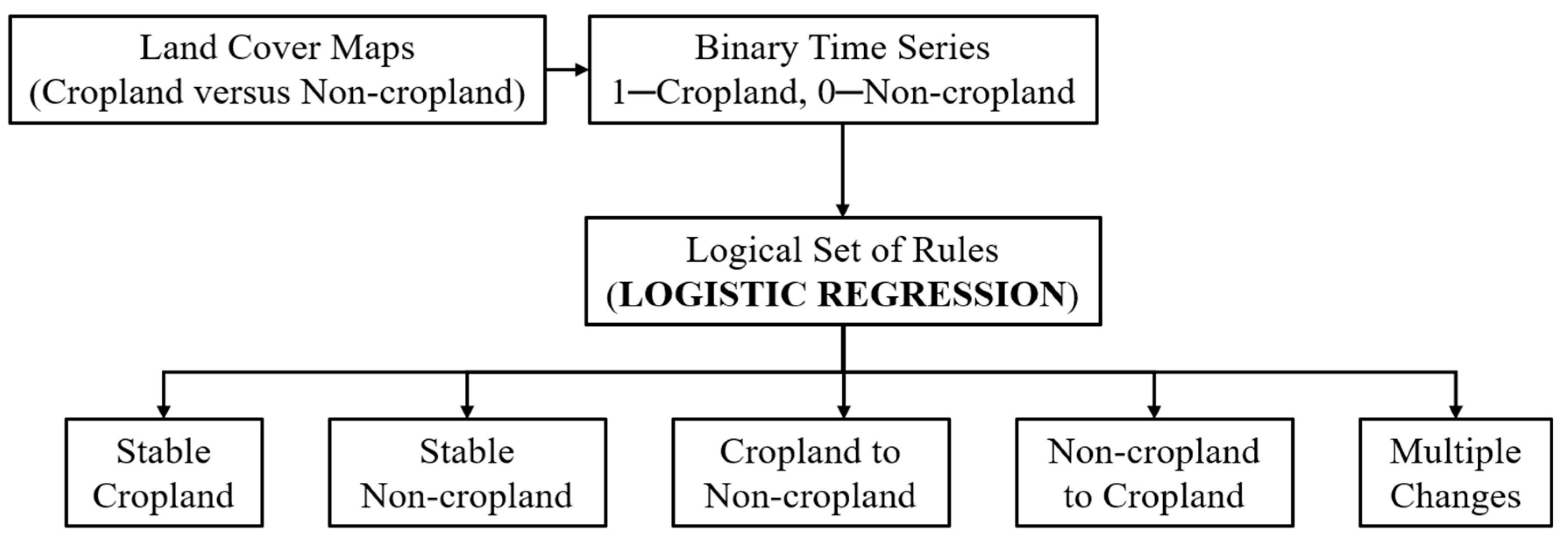
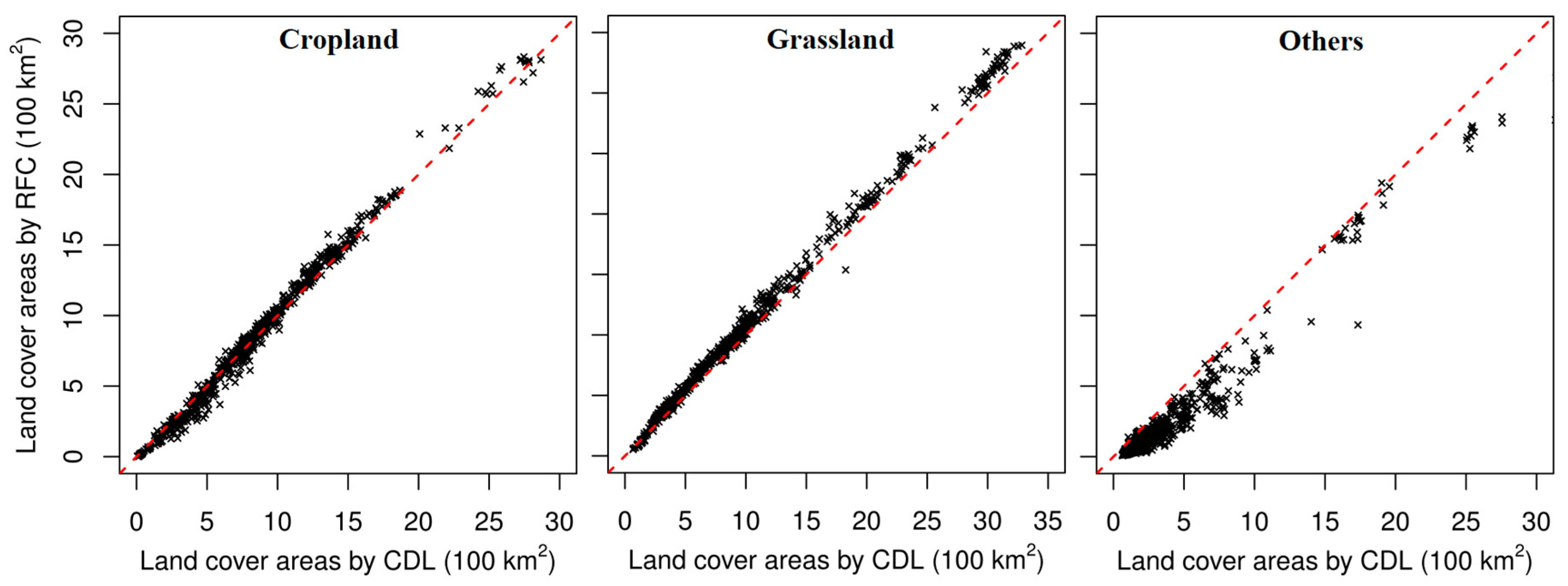
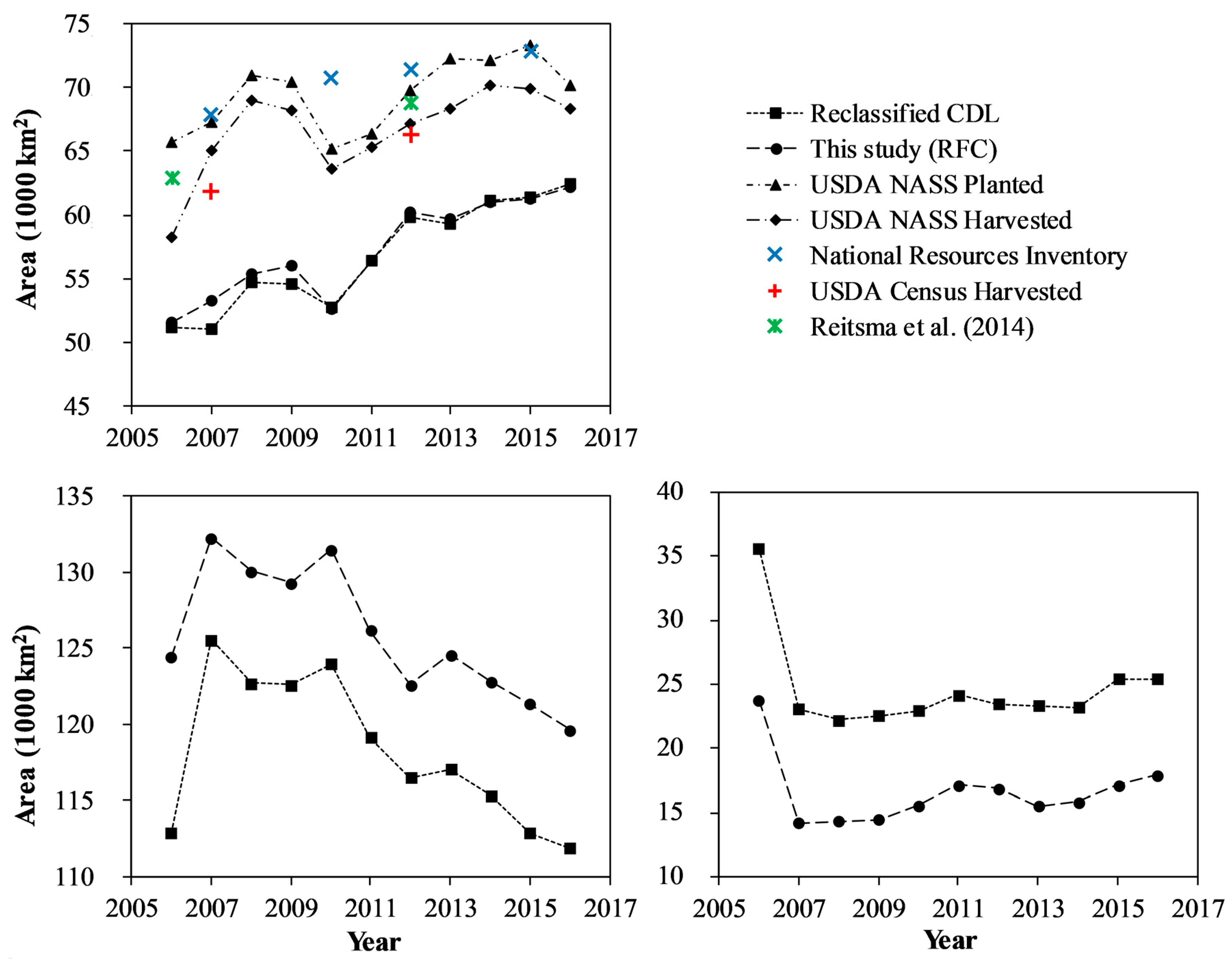
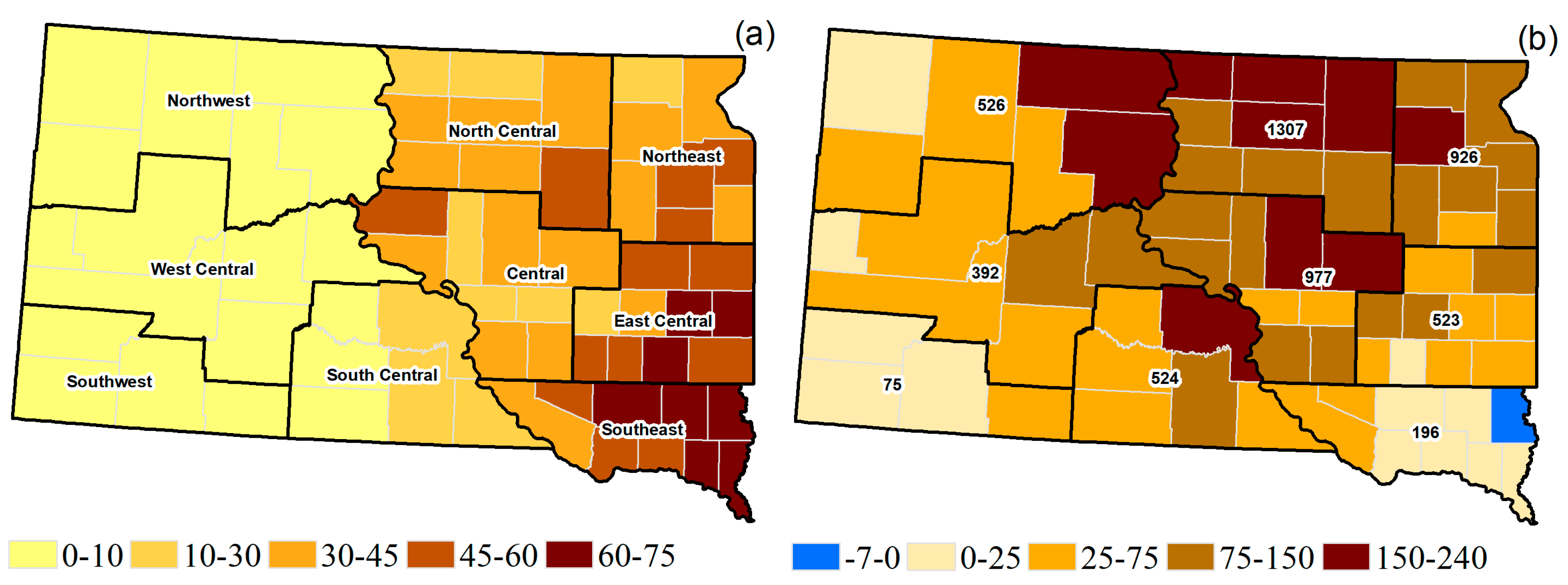
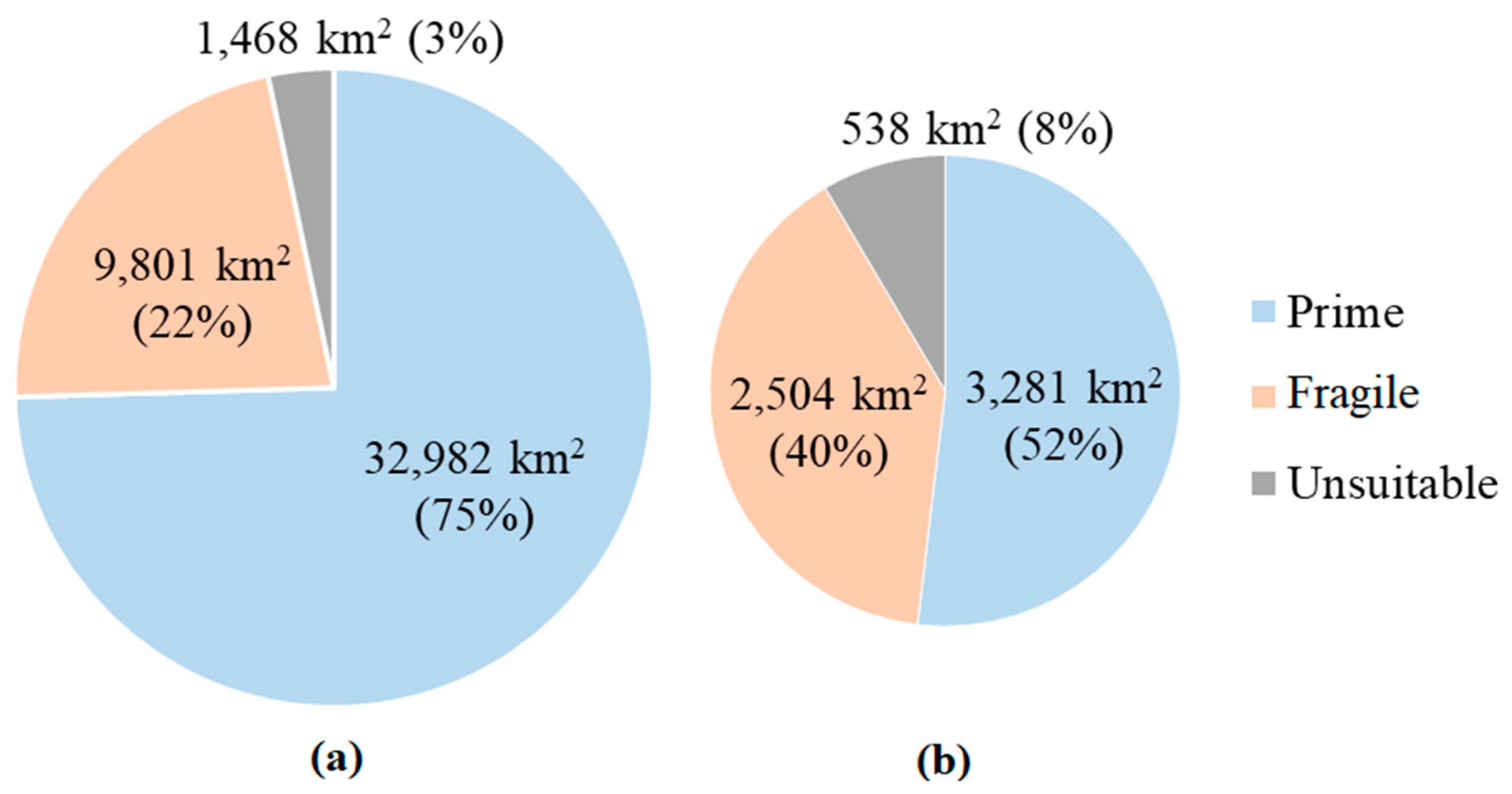
| Year | Dataset | Cropland (UA/PA) | Grassland (UA/PA) | Others (UA/PA) | OA | 95% CI of OA | kappa |
|---|---|---|---|---|---|---|---|
| 2006 | CDL | 89%/85% | 91%/83% | 50%/77% | 83% | 82.65–83.35% | 0.71 |
| RFC | 87%/85% | 87%/87% | 56%/58% | 83% | 82.72–83.28% | 0.70 | |
| 2012 | CDL | 89%/92% | 90%/88% | 66%/67% | 87% | 86.72–87.28% | 0.78 |
| RFC | 85%/89% | 87%/89% | 70%/52% | 85% | 84.77–85.23% | 0.74 | |
| 2014 | CDL | 89%/92% | 90%/88% | 68%/67% | 87% | 86.73–87.27% | 0.78 |
| RFC | 87%/90% | 86%/90% | 70%/49% | 85% | 84.78–85.22% | 0.74 |
© 2019 by the authors. Licensee MDPI, Basel, Switzerland. This article is an open access article distributed under the terms and conditions of the Creative Commons Attribution (CC BY) license (http://creativecommons.org/licenses/by/4.0/).
Share and Cite
Nguyen, L.H.; Joshi, D.R.; Henebry, G.M. Improved Change Detection with Trajectory-Based Approach: Application to Quantify Cropland Expansion in South Dakota. Land 2019, 8, 57. https://doi.org/10.3390/land8040057
Nguyen LH, Joshi DR, Henebry GM. Improved Change Detection with Trajectory-Based Approach: Application to Quantify Cropland Expansion in South Dakota. Land. 2019; 8(4):57. https://doi.org/10.3390/land8040057
Chicago/Turabian StyleNguyen, Lan H., Deepak R. Joshi, and Geoffrey M. Henebry. 2019. "Improved Change Detection with Trajectory-Based Approach: Application to Quantify Cropland Expansion in South Dakota" Land 8, no. 4: 57. https://doi.org/10.3390/land8040057
APA StyleNguyen, L. H., Joshi, D. R., & Henebry, G. M. (2019). Improved Change Detection with Trajectory-Based Approach: Application to Quantify Cropland Expansion in South Dakota. Land, 8(4), 57. https://doi.org/10.3390/land8040057






